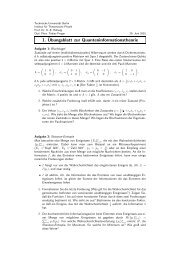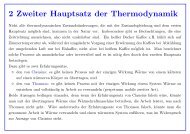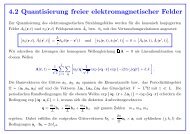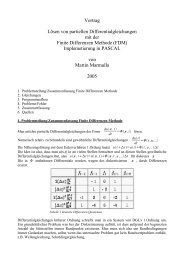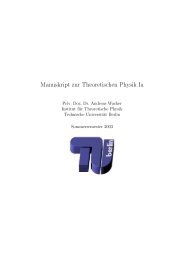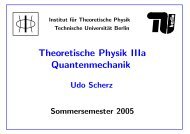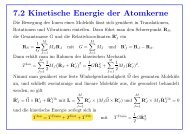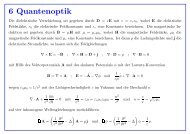1.1 The Radiation Laws and the Birth of Quantum Mechanics
1.1 The Radiation Laws and the Birth of Quantum Mechanics
1.1 The Radiation Laws and the Birth of Quantum Mechanics
You also want an ePaper? Increase the reach of your titles
YUMPU automatically turns print PDFs into web optimized ePapers that Google loves.
QUANTUM MECHANICS I (Dr. T. Br<strong>and</strong>es): Example/Solution Sheets 11<br />
2.7.5 Expectation values (15 min)<br />
Calculate <strong>the</strong> expectation value <strong>of</strong> a) <strong>the</strong> momentum square p 2 <strong>and</strong> b) <strong>the</strong> kinetic energy<br />
<strong>of</strong> a particle in <strong>the</strong> one–dimensional infinite well on <strong>the</strong> interval [0, L] with wave function<br />
Ψ(x, t) = ψ n (x)e −iEnt/ .<br />
SOLUTION: Use ∂x 2ψ n(x) = −(n 2 2 /L 2 )ψ n (x):<br />
〈p 2 〉 t =<br />
∫ L<br />
0<br />
dxψ n (x) 2 ∂ 2 x<br />
i 2<br />
ψ n (x) = − 2 ∫ L<br />
0<br />
dxψ n (x)<br />
(− n2 π 2 )<br />
L 2 ψ n (x)<br />
= n2 2 π 2<br />
L 2 〈 p2<br />
2m 〉 t = n2 2 π 2<br />
2L 2 m 2 = E n. (2.56)<br />
This is a very obvious result: since <strong>the</strong> energy <strong>of</strong> <strong>the</strong> wave function ψ n (x) is E n , <strong>the</strong> expectation<br />
value <strong>of</strong> <strong>the</strong> kinetic energy E = p 2 /2m (= <strong>the</strong> total energy), i.e. <strong>the</strong> value one obtains on averaging<br />
<strong>the</strong> results from many measurements on <strong>the</strong> same system with <strong>the</strong> same wave function, must be E n .<br />
We can obtain this result even easier by calculating <strong>the</strong> expectation value <strong>of</strong> <strong>the</strong> energy<br />
〈Ĥ〉 t =<br />
∫ L<br />
0<br />
dxψ n (x)Hψ n (x) =<br />
∫ L<br />
0<br />
dxψ n (x)E n ψ n (x) = E n , (2.57)<br />
where we have used <strong>the</strong> Schrödinger equation Ĥψ n = E n ψ n <strong>and</strong> <strong>the</strong> orthonormality <strong>of</strong> <strong>the</strong> ψ n .<br />
2.7.6 * Time evolution <strong>of</strong> superposition (10 min)<br />
a) What is <strong>the</strong> time evolution <strong>of</strong> an arbitrary wave function Ψ(x, t = 0),<br />
∞∑<br />
∫ L<br />
Ψ(x, t = 0) = c n ψ n (x), c n = dxψn ∗ (x)Ψ(x) (2.58)<br />
b) Consider <strong>the</strong> wave function<br />
n=0<br />
0<br />
Ψ(x, t = 0) = 1 √<br />
2<br />
(ψ 1 (x) + ψ 2 (x)) . (2.59)<br />
What is <strong>the</strong> probability density to find <strong>the</strong> particle at x at time t<br />
SOLUTION:<br />
a) <strong>The</strong> Schrödinger equation is a linear partial differential equation, so <strong>the</strong> answer is simple: it is<br />
just given by <strong>the</strong> superposition<br />
∞∑<br />
Ψ(x, t) = c n ψ n (x)e −iEnt/ (2.60)<br />
n=0<br />
i∂ t Ψ(x, t) =<br />
=<br />
∞∑<br />
c n E n ψ n (x)e −iEnt/<br />
n=0<br />
∞∑<br />
c n Ĥψ n (x)e −iEnt/<br />
n=0<br />
where we used <strong>the</strong> fact that Ĥ is a linear operator.<br />
b) <strong>The</strong> time evolution is obtained as<br />
= Ĥ<br />
∞∑<br />
c n ψ n (x)e −iEnt/<br />
n=0<br />
= ĤΨ(x, t),<br />
Ψ(x, t) = 1 √<br />
2<br />
(ψ 1 (x)e −iE 1t/ + ψ 2 (x)e −iE 2t/ ) . (2.61)<br />
From this we obtain <strong>the</strong> probability density<br />
|Ψ(x, t)| 2 = 1 (<br />
ψ<br />
2<br />
2 1 (x) + ψ2 2 (x) + 2ψ 1(x)ψ 2 (x) cos[(E 1 − E 2 )t/] ) , (2.62)<br />
which is no longer constant as a function <strong>of</strong> time.




